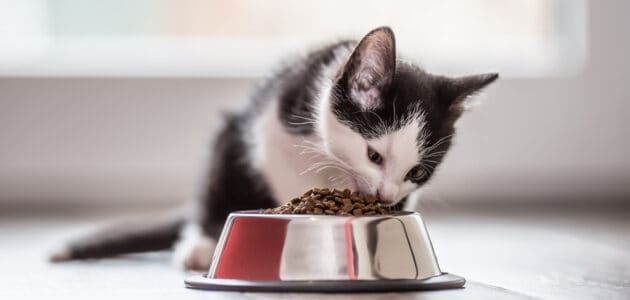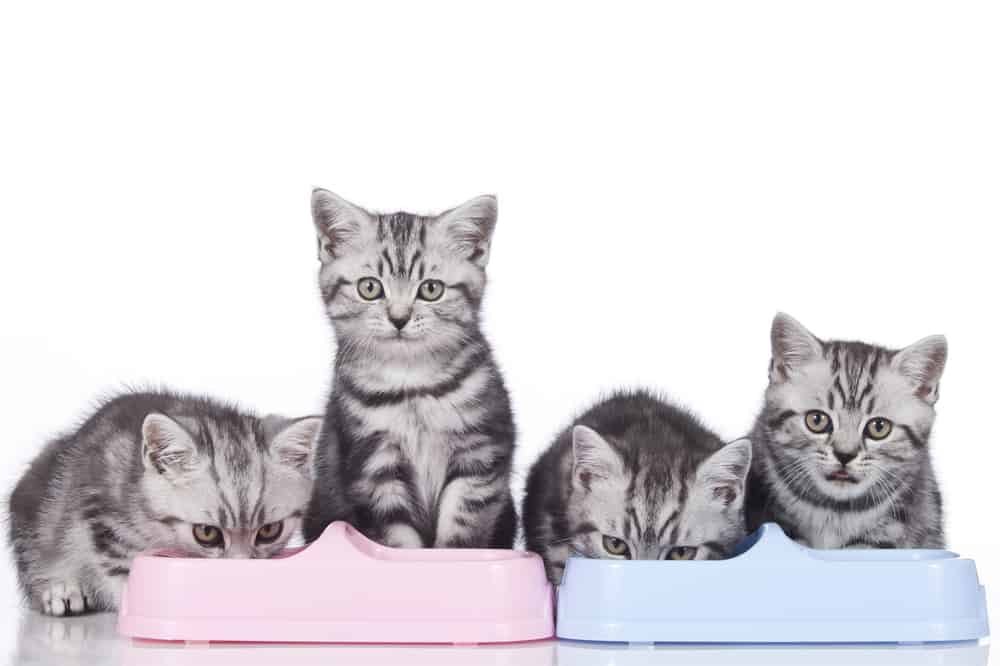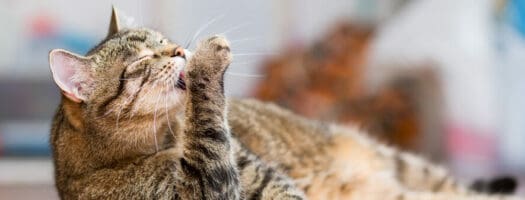How Much Should You Feed a Kitten?

The easiest way to keep your kitten happy is to provide it with a healthy, nutritional diet designed to help them grow. Once you have selected the perfect kitten food, you may be wondering exactly how much you need to feed your kitten. After all, you don’t want them to become overweight or underweight.
How much you should feed your kitten depends on a number of factors such as your kitten’s age, size, breed, and the type of food you are using. In this article, we will discuss all these different considerations and help you figure out the perfect amount to feed your cat.
How Much to Feed a Kitten Based on Life Stages
How much a kitten needs to eat depends on their weight, breed, and age. Frequent meals are important to keep up with a kitten’s energy and nutrition demands.
Below, we will be breaking down the general calorie requirements and amount you should feed your kitten based on life stages, as well as how often you should feed them during each stage. Keep in mind that if you have questions or concerns about your kitten’s feeding routine, you should contact a veterinarian.
Newborn Kittens – Ages 0 to 4 Weeks Old
Newborn kittens should be exclusively fed from their mother’s milk until about four weeks old. If this isn’t possible, you can hand-feed your kitten with a bottle of quality cat milk replacer. You need to be feeding your kitten about 2 tablespoons of kitten formula per 4 ounces of body weight.
You should start out by feeding every 1 to 2 hours to mimic newborn nursing. Gradually decrease this number to 4 to 6 feedings a day by the time your kitten turns 3 weeks old.
4- to 8-Week-Old Kittens
As your kitten reaches 4 weeks old, you can begin transitioning them to more solid kitten foods. This is best done by mixing wet kitten food with kitten formula. You can first feed them this mixture from a bottle, and then a bowl, using less formula with each feed. Your kitten may need up to 60 calories per pound of body weight and will need to eat every 4 to 6 hours.
8- to 16-Week-Old Kittens
Between 8 to 10 weeks of age, your kitten should be fully weaned and eating a protein-rich wet or dry kitten food. Your kitten will need approximately 250 to 280 calories per day. If you have a larger breed cat such as a Maine Coon or a Ragdoll, they may need up to 360 calories a day.
You should spread your kitten’s daily calorie intake out among every 6 hours. You can also start to free feed with dry food at this age, but be careful to monitor your kitten and make sure they aren’t gaining too much weight.
4- to 6-Month-Old Kittens
Kittens between 4- and 6-months old start to settle into their dietary preferences. It is important to feed a varied, flavorful diet of both wet and dry food at this point to keep your kitten from being too picky as an adult. If your kitten is primarily fed dry food at this age, it is likely they will refuse wet food later on in life.
Your kitten will need twice as many calories per pound as an adult cat at this point. This works out to about 30 calories per pound of body weight per day. You should refer to the caloric guidelines on your kitten’s food to determine the correct amount to feed.
At this point, you can gradually decrease your kitten’s feedings to about 6 to 8 hours between meals.
6-Month-Old Kittens to Adult Cats
Around 6 months old, your kitten’s metabolism starts to slow down, and their nutritional and caloric needs begin to develop into those of an adult cat. Your kitten will continue to grow until approximately their first birthday, but many larger breeds continue growing until they are 3 to 4 years old.
The number of calories your kitten needs at this point is determined by their existing weight, any underlying health conditions, and their breed. The general guidelines for feeding a cat of this age and into adulthood is to give them around 20 calories per pound of body weight. You can also decrease their feedings to twice a day.

Kitten Nutrition Requirements
Kittens have very different nutrition requirements to those of adult cats. During the first year of their life, they experience exponential growth and need to intake high amounts of calories to keep up with their energetic lifestyle and develop properly.
While a kitten’s need for most vitamins, fats, and certain fatty acids match that of an adult cat, they will have higher requirements when it comes to proteins, amino acids, minerals, and certain vitamins like DHA. In fact, kittens should be getting about 30 percent of their energy from a quality protein in their diet.
It is important to feed your kitten a specially-formulated kitten food for their first entire year of life; kitten food provides the exact balance of nutrients and calories a kitten needs to grow, unlike adult food, which could leave them lacking.
Some all-life-stages food could be ok for use with kittens, but it is recommended that you only use this type of food for older kittens (approximately 8 months and up) and make sure it is a good quality food. An all-life-stages food can be helpful when you have multiple cats of different ages in one household.
Wet vs Dry Food
The decision to feed your kitten wet or dry food has long been debated by pet parents and experts alike. Both food types have their pros and cons, so it really comes down to what works best for you and your cat.
That being said, very young kittens can benefit more from wet food because it is easier for them to eat before their teeth fully grow in. Once your kitten has proper teeth, you can give them either dry or wet food.
Dry food is better for a kitten’s teeth as the rough texture will remove plaque while they chew. On the downside, it does not have as high of moisture content as wet food does, so you will need to make sure your kitten drinks enough water if you are feeding them a solely dry food diet.
Wet food can be more expensive than dry food, and you will have to feed your kitten more wet food than you would dry food to reach the same amount of nutrients.
Most experts recommend using both wet and dry food in your kitten’s diet to give them the best of both worlds; half of their meals should include wet food and half dry. Of course, this will take a little extra work to figure out the perfect caloric and nutrient content of each serving to make sure you don’t under- or overfeed your kitten.
Kitten Feeding Tips
Making sure your kitten has the right amount of food each day can sometimes be a difficult task, but it is an important one. With a healthy diet, your kitten will be nutritionally supported and grow up to be a happy, fit cat.
When feeding your kitten, there are a few things you can take into consideration to make feeding times more pleasant.
Avoid Certain Foods
It may be tempting to share whatever you are eating with your kitten, but there are certain foods that your kitten should never come into contact with. One of the most toxic foods kittens and cats can have is chocolate. Chocolate has both theobromine and caffeine in it which can cause heart failure and seizures in felines. The higher the cacao content in the chocolate, the more dangerous it is. Contact a veterinarian immediately if your cat has ingested chocolate.
Other dangerous kitten foods include grapes and raisins, which can cause kidney failure; onions and garlic, which can cause digestive upset and anemia; caffeine, which can cause increased breathing and heart rate; and alcohol, which can cause severe brain and liver damage.
There are other foods and plants kittens and cats shouldn’t be near, and you can find complete lists of these here and here. In order to keep your furry friend healthy and happy, pay attention to what they are eating and make sure they don’t come into contact with anything potentially harmful.
Don’t Use Plastic Bowls
Putting your kitten’s food and water into plastic bowls can give it a strange aftertaste that cats don’t like. They could start refusing food and water because of the taste. To remedy this, invest in a set of quality stainless steel or ceramic bowls. Not only will food and water taste better to your kitten, but these bowls are also more sanitary and easier to clean.
Always Keep out Fresh Water
Fresh, clean water is an important part of your kitten’s diet. Cats are prone to developing chronic dehydration, kidney issues, and bladder stones if they do not have access to enough water, especially if they are on an exclusive dry food diet.
Leave at least one bowl of water out for your kitten in a quiet place, away from both the litter box and their food bowl. This will encourage them to drink more water. You can also put water bowls in safe areas around your house so your kitty has their pick of where to hydrate.
Transition to New Food Slowly
Once your kitten is set in their diet, you may find yourself wanting to switch them to a new food or add more variety into your kitten’s feeding routine. This is a process that should be done slowly to avoid causing digestive upsets in your kitten.
Transitioning to a new food should be done gradually, over the course of several days. To start, mix the new food you want your kitten to try with their old food in a ratio of ¼ to ¾. Gradually increase the amount of new food in the mix until that is all they are eating.
During the transition, monitor your kitten’s reaction to the food. If they start refusing meals, become itchy or develop skin rashes, begin vomiting, or have diarrhea, stop feeding the new food and consult a veterinarian.
Go Easy on the Treats
Kitten treats come in a variety of flavors, shapes, sizes, and textures, and are usually signified by the phrasing of “for supplemental feeding only” on the package. While they are a great snack or reward for your pet, you should be careful not to feed your kitten too many.
Treats have low nutritional value and are typically high in carbohydrates and calories. Feeding your kitten too many can result in obesity or other health issues. Remember, only 10 to 15 percent of your cat’s diet should come from treats.
Keeping Your Kitty Happy
While keeping your kitten happy may seem as simple as just feeding and playing with them, there are a lot more things to be considered. Everything from the type of kitten food you use to how much you feed your kitten has an impact on their health and overall happiness.
However, as long as you are careful to select a quality, nutritionally balanced kitten food and follow the caloric guidelines set for kittens, you are sure to keep your kitten thriving as they grow into an adult.




